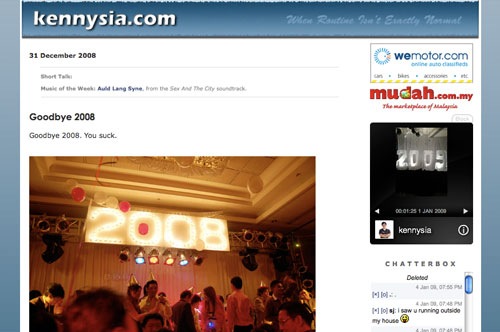Continuation of my previous post: Introducing the Blogosphere.
Blogs are emerging as a new platform to form communities online.
Blogs can be classified simply according to media type such as sketchlogs, photoblogs, and vlogs, and subject matter such as politics, travel, and lifestyle. Media analyst Margaret Simons (Funnell 2008) classified blogs more elaborately into the ‘Digest’ blog, the ‘Popular Mechanic’ blog, the Exhibition blog, the Gatewatcher blog, the Diary, the News blog and the advocacy blog. However, there are bloggers who do not stick to a particular niche or even a particular format which makes categorizing blogs a difficult exercise.
According to White (2006), there are several ways blogging communities form. Most of the time, blogs are formed around a shared interest that develops into a passion. There is the Single Blog/Blogger Centric Community, the Central Connecting Topic Community and the Boundaried Community. The first form of blogging community is the Blogger Centric Community as illustrated in the diagram below.
 Figure 1: Single Blog/Blogger Centric Community
Figure 1: Single Blog/Blogger Centric Community
The blog is owned by an A list blogger or an organization, and the community grows through the participation of interested or curious commentors in topics controlled by the blogger. Everything is mainly controlled by the blogger; he has the power to disable comments to control the desired level of interaction with his readers.
One of the examples of Blogger Centric communities can be found on kennysia.com.
 Figure 2: Snapshot of kennysia.com
Figure 2: Snapshot of kennysia.com
Kennysia.com was created on 5 January 2009 (Sia 2009). It started out as a personal blog, but evolved into something that is more lifestyle-oriented with doses of political parody. This is because as kennysia.com became more popular, blogging about personal relationships caused friction between himselves and his loved ones. His blog grew because it was entertaining and provoked response and interaction among readers. One of his posts actually received 742 comments (Sia, 2009).
Even as social networking sites such as Facebook and MySpace threaten to dominate cyberspace, it is predicted that blogging will once again rise as an important platform to build online identities (Cunliffe 2009). Self-made blog templates are on the increase, as well as wider screen designs to enable displaying larger photos and widescreen videos. Social networking tools such as Twitter will also be increasingly incorporated into blogs (Cunliffe 2009).
Today, RSS (Really Simple Syndication) and feedreaders are offering new possibilities about how we discover and read blogs (White 2006). Micro-blogging tools like Plurk and Plinky are becoming more and more dominant. It can be expected that as technology continues to evolve, blogging communities will become more diverse in their chosen genres, blogging platforms, and blogging or reading methods.

No comments:
Post a Comment